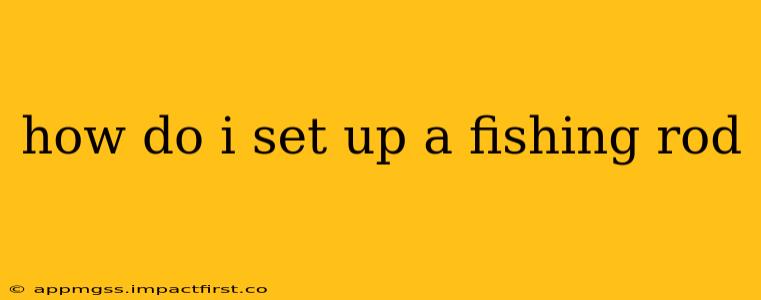Setting up a fishing rod might seem straightforward, but mastering the nuances can significantly improve your fishing experience. This guide covers everything from choosing the right components to assembling and maintaining your gear, ensuring you're ready for your next angling adventure.
What You'll Need Before You Begin
Before diving into the setup process, gather your necessary equipment. This includes your fishing rod, fishing reel, fishing line, and potentially rod guides (if not already installed). You might also need line clippers or scissors, and possibly a lubricant for the reel.
Step-by-Step Guide to Setting Up Your Fishing Rod
1. Attaching the Reel to the Rod: This is the foundational step. Most rods have a reel seat, a section specifically designed for the reel. Ensure the reel is compatible with your rod. Generally, you'll slide the reel onto the reel seat, ensuring it's snug and secure. Some reels might require tightening screws or locking mechanisms.
2. Spooling the Fishing Line: This involves carefully loading the line onto the reel spool. Begin by threading the line through the line guides on the rod, starting from the tip and working your way down. Then, attach the line to the spool of your reel and begin winding it evenly. Avoid overcrowding the spool; leave some space at the top. Many anglers use a line winder for even spooling.
3. Knot Tying: Secure the end of the line with a reliable knot. The Palomar knot is a strong and popular choice, but others like the improved clinch knot or uni-knot are also effective. Proper knot-tying is crucial to prevent line breakage. Practice your knot-tying skills beforehand.
4. Testing the Setup: After completing these steps, gently cast your line a few times. Check for any snags or issues with the line flow. If you feel any resistance or notice the line is tangled, carefully untangle it and re-check your work.
Troubleshooting Common Problems
My Reel Isn't Spinning Smoothly:
This is a common issue often caused by lack of lubrication. Use a reel lubricant designed for fishing reels and follow the manufacturer's instructions. If the problem persists, it could indicate a more significant issue requiring professional repair.
My Line Keeps Snagging:
Snagging usually happens due to improper line spooling, a damaged line guide, or a poorly tied knot. Inspect your spool for unevenness or tangles, check your line guides for any damage, and double-check your knot for tightness and security.
I'm Having Trouble Casting:
Casting difficulties often stem from an incorrect grip, poor line management, or improper technique. Practice your casting technique in an open space. Consider watching videos or seeking guidance from experienced anglers.
What Type of Line Should I Use?
The type of fishing line you choose depends on the type of fish you are targeting and your fishing style. Popular choices include monofilament, fluorocarbon, and braided lines, each offering unique strengths and weaknesses. Research the best line type for your specific needs.
How Often Should I Replace My Line?
Fishing line degrades over time due to sun exposure, friction, and general wear and tear. It’s good practice to inspect your line frequently for any signs of damage. Replace it regularly – at least once or twice a year, or more frequently if you notice visible damage. A broken line can lead to lost fish and frustration.
This comprehensive guide should equip you with the knowledge to confidently set up your fishing rod and enjoy countless hours of successful fishing. Remember, practice makes perfect! With some patience and attention to detail, you'll quickly become proficient in preparing your gear.
